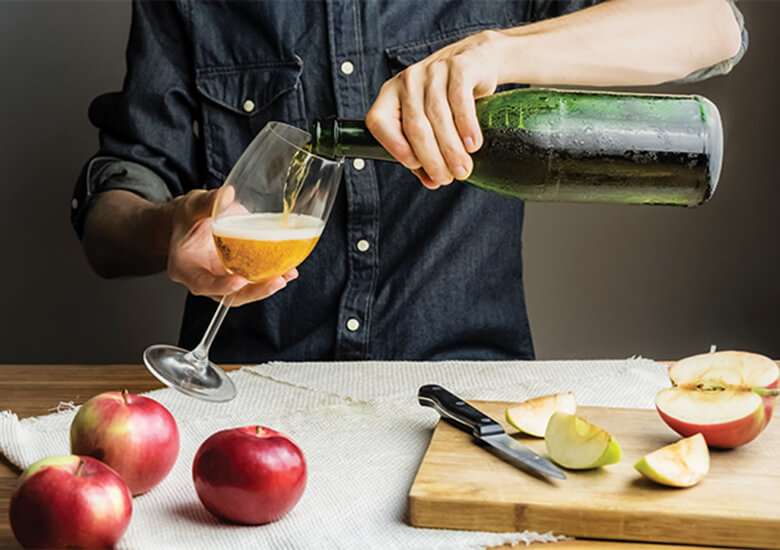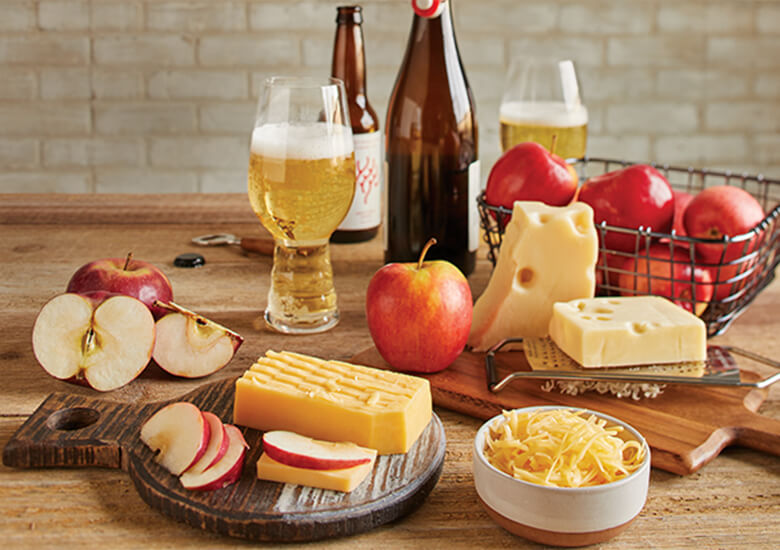When it's apple season, there’s no better way to enjoy it than sipping a glass of sparkling hard cider on a crisp fall day. But here’s even better news—you can cook with it, too! Use it in a cheese sauce, brine your Thanksgiving turkey, or add a splash to an autumnal vinaigrette. Not sure where to start? Give these recipes that feature hard cider and Wisconsin artisan cheeses a go.
Say “Hello” to Hard Cider

Wisconsin enjoys the wonderful world of hard apple cider almost as much as it enjoys its cheese. After all, who doesn't love local handpicked goodness pressed into something special worth sipping? From how to serve it to the apples sourced to produce it, here’s a bushel of insight from three local experts. They’re sharing why hard cider is a hometown hero.
Wisconsin is known as a beer state. Where does hard apple cider fit in?
A. Hard cider is quickly growing in popularity year after year and becoming a staple in the state. While Wisconsin is known for its long history of beer making, hard cider producers are constantly innovating their product. New hard cider tasting rooms are opening and creating meeting places for a growing community of people. The support from this blossoming community and dedication from creative cider makers are the very things that will propel hard cider into the future. –Walker Fanning, owner of Hidden Cave Cidery, Middleton, WI
Hidden Cave Cidery produces unique hard ciders from simple recipes using Wisconsin apples and Wisconsin honey.
How do you serve hard apple cider? Are there any foods it pairs especially well with?
We like to serve our cider in canning jars, because they're rustic and simple—an ideal choice for a beverage that starts with apples from local orchards. Others prefer to serve hard cider in wine or champagne glasses. If the cider is high quality, it can hold its own in fancy glassware.
People visiting our tasting room and restaurant are often surprised by the flavors that come through in hard ciders and that they pair well with almost any food, especially cheeses. The bubbles, fruitiness, acidity, and aromas in hard cider contrast the creaminess and complement flavor profiles found in many of the great cheeses made in Wisconsin. There are many amazing combinations to discover. –Matt Raboin, co-owner of Brix Cider, Mount Horeb, WI
Brix Cider makes their ciders with locally grown apples, sourcing from small Wisconsin farms. They pair them with other local ingredients and dishes made in their farm-to-table restaurant.
What type of apples are used to create hard cider?
Q. In Europe, cider apples are specially cultivated just to make alcoholic beverages. French and English varieties are held in the same high regard as the grapes used to make wine. In America, apple production has been concentrated on culinary or table apples. We cultivate French and English cider apples at The Cider Farm.
With the apple varieties available, there are two emerging strands of cider styles in America. "Modern” ciders are crafted with table apples and other ingredients to elevate character and flavors, while “heritage” ciders are made with specific, true cider apples. Heritage ciders have fewer additives and generally a lower sugar content. –John Biondi, owner of The Cider Farm, Mineral Point, WI
The Cider Farm makes small-batch hard ciders and apple brandy with organically grown, true English and French cider apples.
Cider Tasting 101

New to hard apple cider?
Here are several key terms to know.
Acidity-Apples used to make cider range in acidity—too high and it tastes like vinegar, too low and it tastes flat. The right amount highlights flavors.
Carbonation-Detected visually and by mouthfeel, bubbles in cider range from still (little to none) to pétillant (moderate) to sparkling (high).
Clarity-Describes how clear or cloudy a cider is in appearance. Clarity ranges from cloudy to hazy to clear to brilliant.
Mouthfeel-Hard ciders range in level of dryness and vary in viscosity. They can be thin like water, syrupy or full-bodied like juice.
Tannins-Similar to red wine, hard ciders can have tannins that add a drier mouthfeel and also help balance sweetness.
Pairing cheese with hard apple cider

Harvest the richness of fall with two quintessential seasonal favorites: Wisconsin artisan cheese and hard cider. With so many creative hard apple cider flavors available—fruited, herbal and more – the pairing potential is endless. Get started with these suggestions or experiment with your favorite Wisconsin cheeses!
Fruited Cider + Renard’s 1 Year Cheddar Cheese
A natural pair, the crisp notes in a fruit-forward cider balance the creamy and slightly sharp taste of aged cheddar.
Herbal Cider + Carr Valley Fontina Cheese
Fontina’s creamy texture and crowd-pleasing, mild, and nutty flavors give this cider’s herbal notes a chance to blossom.
Semisweet Cider + Roth Buttermilk Blue® Cheese
Lightly sweet and bubbly, juxtapose this cider with Roth's creamy, tangy yet mellow blue cheese for a pairing rich with flavor.
Dry Cider + Marieke® Gouda Aged Cheese
Slightly crystalized with nutty notes, this aged gouda is an ideal match for dry cider’s complex apple and fruity flavors.
